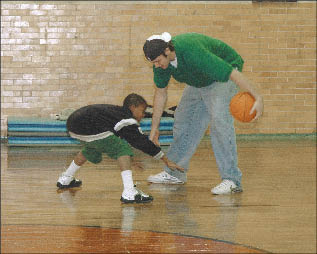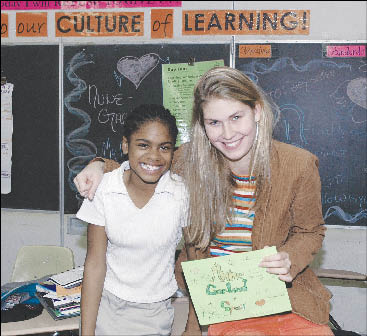 |
|
Teamwork: Big brother Tim Bagley plays with his little, Raymond, at Shaw Middle School in Philadelphia, as part of school-based mentoring program. Photo: Photo courtesy of BBBSA |
While school-based mentoring has been a cornerstone in the rapid growth of mentoring in recent years, it is sometimes derided as a sort of “mentoring lite.” Sure, the school-based strategy makes it easier to recruit mentors and reach more kids, but suspicions abound that it’s a cheap imitation that drives up numbers but produces little impact.
The most rigorous scientific study yet of a school-based mentoring (SBM) program shows that it does have some positive impact on youth, but the effects tend to be few and short-lived. To achieve more, SBM programs will have to move beyond the school building and the school calendar.
In other words, they need to look more like traditional, community-based mentoring.
The challenge is how to do that while keeping the advantages that make SBM so attractive to operate. Big Brothers Big Sisters of America (BBBSA), which commissioned the study, is already instituting changes based on its findings – findings to which other SBM programs are paying heed, because of the implications for their work as well.
The results “do concern us,” says Lisa Falcone, who coordinates Fighting Back, an SBM program in Santa Barbara, Calif.
Among the findings: The SBMs showed limited academic benefits during the first year, even less in the second, and virtually no benefits in nonacademic areas. In many ways, that confirms what a few early SBM studies showed and what practitioners felt.
“The findings were really not surprising to us,” says Joe Radelet, vice president of mentoring programs at BBBSA. “It gives us a good foundation for why and how we need to strengthen our model and practice.”
For SBM programs that want to follow that strengthening approach, the cost will probably include more screening, training and supervision of volunteers, and reaching fewer youth than they otherwise would.
Need for Evidence
 |
|
Name tag: Big sister Ann Garland shows off artwork by her little, Sakeena, at Shaw Middle School in Philadelphia. Photo: Photo courtesy of BBBSA |
For mentoring programs, which typically have waiting lists of youths and a shortage of mentors, SBM solves a lot of headaches. Because the volunteer time commitment is small compared with traditional mentoring – with meetings typically taking place only at school, once or twice a week – it is far easier to recruit mentors. Because the pairs typically do not meet alone and the mentors don’t get as involved in the youths’ lives, screening and training are often not as extensive.
That’s why “more and more communities are opting for school-based mentoring,” says Susan G. Weinberger, a pioneer of SBM in the 1980s and now president of Mentor Consulting Group. SBM, she said, “opened the doors to every other kind of configuration that has occurred since. It has spearheaded an entire growth of the movement beyond anything we could ever have expected.”
BBBSA estimates that nearly 870,000 youth are served through SBM programs. No one does it more than BBBSA: From 1996 to 2006, the number of its school-based matches more than quadrupled, from 27,000 to 126,000. SBM now accounts for half of all BBBSA matches.
The growth of SBM, however, has outpaced evidence of its impact. Little research has been done on it, and researchers have surmised that it would have less impact than traditional mentoring because of the lesser intensity and duration of the relationships.
Some programs, including BBBSA and YouthFriends – a network of programs in Missouri and Kansas – have commissioned studies that showed short-term gains in academics and self-reported improvements in relationships. But the studies have been based largely on surveys of youth, parents and teachers, or on short-term data.
In 2003, with funding from The Atlantic Philanthropies, Philip Morris USA and the William T. Grant Foundation, BBBSA hired Public/Private Ventures (P/PV) to measure the impact of its school-based mentoring beyond one academic year.
Results
P/PV conducted a 15-month study of 1,139 youths in grades four through nine at more than 70 schools served by 10 BBBS agencies around the country. During the 2004-05 academic year, 565 students were randomly assigned to receive a school-based mentor. The second year outcomes were severely affected by high attrition rates due to student transfers and volunteer turnover; only 52 percent of all “littles” had a match during the 2005-06 academic year.
The study found significant positive first-year impacts on nine of 23 school-related measures: overall academic performance; written and oral language performance; performance in science; quality of class work; number of assignments completed; absences without an excuse; initiation of skipping school; serious school misconduct; and scholastic efficacy (feeling more academically competent).
In the second year, however, the only positive academic impacts were the initiation of skipping school and the feeling among participants that they would attend and finish college.
That confirms “what other studies have shown: Short-term programs for youth do not induce long-term change,” the study notes.
The researchers found evidence that longer matches and closer relationships between bigs and littles were associated with stronger impacts, and that summer meetings appeared to lengthen and strengthen the relationships.
Such commonsense reasoning is why Fighting Back, which serves fourth- through eight-graders in 30 Santa Barbara schools, encourages mentors to start meeting with youths outside of school and during the summer, Falcone says. But such extensions of SBM are unusual.
Nevertheless, Falcone is looking at how the study might inform her work, because pre- and post-program surveys of Fighting Back participants also tend to show academic gains but not “big impacts” in other areas. She wants to find ways to improve outcomes as well as evaluation methods.
Watching BBBSA respond to its findings might be wise; it has the money and manpower to make evidence-based reforms that other agencies can pick up.
Remodeling
By June 2006, study author Carla Herrera of P/PV had communicated preliminary findings to BBBSA. “We knew two things,” Radelet says. “One was that there were positive results in the first year, and that by the middle of the second year most of those positive results were not sustained.”
 |
|
Radelet: “The findings were really not surprising to us.” Photo: Photo courtesy of BBBSA |
It was clear that national headquarters had concerns not only about the effectiveness of its SBM, but about how those findings would be received by agencies and the public.
BBBSA created a task force of 10 agency representatives under the leadership of Robin Temichko, CEO of BBBS of Central Maryland. The task force had to be headed by an agency leader, Radelet says, because national headquarters wanted the feedback to “be at the ground level in terms of practice.”
“We wanted to know what agencies were doing to improve their school-based model and practice, and we wanted to know how that connected with the findings we anticipated from the study,” he says.
By this past April the task force produced a tool kit for affiliates that included a summary of the study; steps to strengthen the SBM model; a suggested “key message,” communications strategy and guidance on media and public outreach; and a commitment contract for agencies to show support for the task force recommendations.
The tool kit was distributed at 16 “mini-symposiums” held in May for representatives from 164 of the 415 BBBSA agencies. Radelet says national headquarters asked the agencies to go on record as supporting the recommendations of the study and the task force, and to “set new goals for extending the length” of the SBM matches.
So far, 125 agencies have signed on, according to Radelet. He says BBBSA wants 80 percent of the agencies to be on board by the end of next year.
The tool kit strategies included:
• Lengthen matches to a minimum of one calendar year, and encourage multi-year commitments by mentors, effectively “taking SBM out of the school year.”
• Deepen and formalize partnerships with schools and businesses. • Provide more volunteer training and enhanced match support.
What it actually means to pursue those steps is becoming clear as various SBM programs try to implement them.
Local Impact
Both within BBBSA and beyond, some agencies are already coping with the issues raised by the study, while others are figuring out how they can.
• Mentor longevity: At BBBS of Kentuckiana, based in Louisville, Ky., Executive Director Jeri Swinton says the agency is focusing more on recruiting mentors who “would be more likely to be able to have a longer match relationship.” One reason for high mentor turnover at BBBSA agencies was that about half the mentors in the study were high school students, which raises questions about the extent and value of peer mentoring. (See related story, page 28.)
So while Swinton’s agency still welcomes students, it is trying harder to recruit 25- to 45-year-olds, who tend to be more settled.
YouthFriends, based in Kansas City, Mo., seems to have largely solved that problem. Agency President Lisa Adkins says 64 percent of the mentors in the 2005-06 school year returned for 2006-07, and that more than 20 percent have been with the agency for at least five years.
One key factor, Adkins believes, is that only about 180 of this past year’s 4,000 school-based mentors were high schoolers. She says 44 percent of her mentors are 50 or older.
BBBS of Kentuckiana is also trying to build more partnerships with corporations. Swinton notes that when companies let employees conduct mentoring during the work day, those mentors tend to stick with the program longer.
• Beyond School: A major advantage of restricting SBM meetings to school grounds is that the site is fairly secure, the meetings are out in the open and there is lots of adult supervision. Allowing out-of-school activities creates new administrative demands on agencies, especially in volunteer screening, training and supervision.
Agency staff members have to conduct more reference checks and have more contact with the youths’ parents, rather than just the school, to get permission for and feedback about the mentors’ activities with the youths. At BBBS of Kentuckiana, Swinton notes that her agency now has to “look more at driving records. When they’re seeing the child [only] at school, that’s irrelevant.”
She says the added staff tasks will probably mean less growth in the SBM program.
At Fighting Back, Falcone says mentors can start meeting with youths outside of school after the match is six months old. The program, run by the Santa Barbara Council on Alcoholism and Drug Abuse, gets parental permission and requires the meetings to occur in public places, like libraries.
The dilemma is evident in talking with Adkins at YouthFriends. “How you do the summer contact is complicated,” she muses, immediately stressing, “not that we’re not cognizant of the fact that that [the summer vacation] causes a break in the relationship. How do you keep the relationship going if there isn’t real contact?”
YouthFriends lets mentors give youths journals to keep during the summer, so they can go over them when school begins in the fall, as well as preaddressed postcards for the youths to write notes to their mentors. The mentors, however, cannot write back.
“We have tried to put different practices in place to at least keep the thought of that relationship going,” Adkins says. “At this point, that’s the best we’ve come up with.”
• Training: For many agencies, more volunteer training is in order. The study found that the BBBSA training for school-based mentors averaged one hour or less, pointing to a common inadequacy in SBM programs.
“Many programs offer limited training,” says Robin Cox, founder of an Australia-based mentor training program called Youth Empowerment Seminars (YES). As a result, she says, “many of these mentors might feel ill-equipped to tackle too many issues related to encouraging young people to reach their potential.”
A Place for SBM
So does SBM get scaled back? The question, the P/PV researchers say, is “whether programs and their funders can reach all of the youth … they want to serve using a single model.” The experience of BBBS and other programs, they write, “suggest they cannot.”
SBM can complement community-based mentoring by reaching different youths and volunteers. Dan Bassill, president of the Chicago-based Tutor/Mentor Connection, says it’s “really important” to remember that “this is not an ‘either/or’ choice. The reality is that kids need a whole lot of different types of mentoring/learning.”
The BBBSA experience shows that SBM draws different youths and volunteers than does community-based mentoring. The study found that nearly all referrals to BBBSA’s traditional mentoring comes from the mothers of potential mentees, while most referrals to SBMs come from teachers and school counselors.
Radelet notes that while the community-based approach might be best for youth who need role models, SBM might be best suited to youth who would benefit from additional attention in school and an incentive to go to school.
The study also found that SBMs draw volunteers from among college and high school students, and through companies that let their employees participate during the work day. “These are groups of mentors who aren’t involved nearly as much” in traditional mentoring, Radelet says.
What’s crucial to keep in mind are the different objectives and potential results of short- and long-term youth development strategies. “While a short-term mentoring relationship might have an impact on the self-image of a youth who needs some extra adult attention,” Bassill says, “only long-term, comprehensive programs will help kids from poverty stay in school and have adult networks that help them enter college or careers.”






























